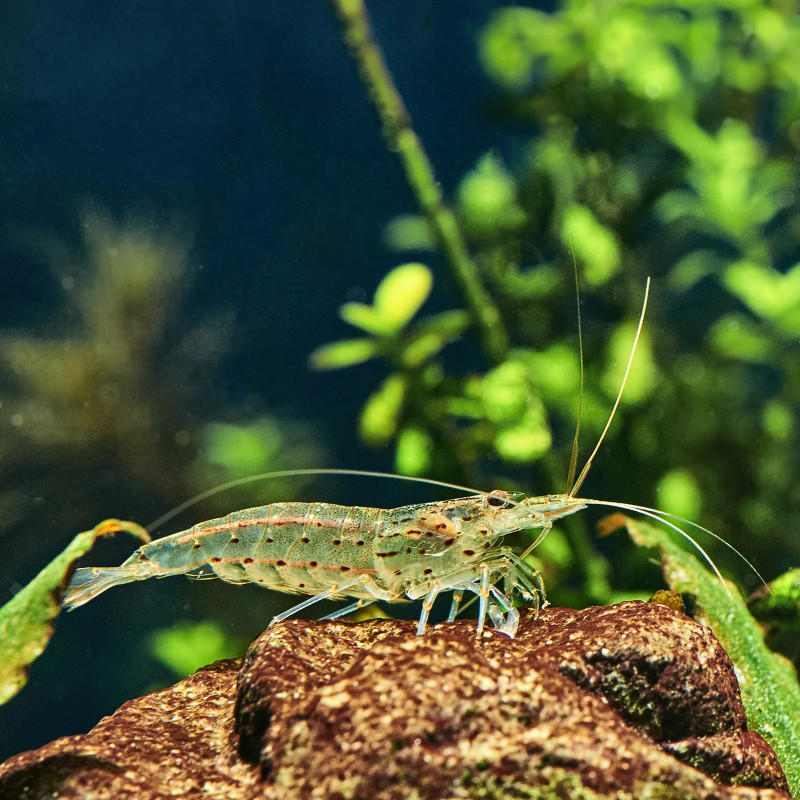Stocks Available
Blue Shrimp - Medium
SKU:126086
NEOCARIDINA DAVIDI
0.75 INCH

Stock Available
Introduction: • Species: Amano Shrimp • Common Names: Amano Shrimp, Yamato Numa Ebi • Natural Habitat: Native to freshwater rivers and streams in Japan and Southeast Asia, often found in areas with dense aquatic vegetation and a moderate flow of water. Physical Characteristics: • Appearance: Recognizable by their transparent bodies with a greenish or brown tint, covered in tiny speckles. They have long antennae and can grow small, white spots along their sides, contributing to their distinctive look. • Size: Typically reach lengths of about 2 inches (5 cm). • Lifespan: Can live for approximately 2 to 3 years under optimal conditions. Habitat Requirements: • Tank Size: A minimum of 10 gallons is recommended, although larger tanks provide better stability and space for movement. • Water Conditions: o Temperature: Prefers water temperatures between 70-78°F (21-26°C). o pH: Thrives in slightly acidic to neutral pH levels, ideally between 6.0 and 7.5. • Aquascaping: A well-planted aquarium with plenty of hiding spots using driftwood, rocks, and dense foliage helps replicate their natural habitat. Diet: • Primary Diet: Omnivorous; feeds on algae, detritus, and decomposing plant material in the wild. • Supplemental Feeding: Provide high-quality shrimp pellets, algae wafers, and blanched vegetables (like spinach or zucchini) to ensure a balanced diet. • Feeding Frequency: Small amounts should be offered daily, allowing for easy consumption to prevent food waste and water quality issues. Compatibility: • Temperament: Generally peaceful and social, making them excellent additions to community tanks. • Suitable Tank Mates: Compatible with other small, non-aggressive fish and invertebrates; good choices include neon tetras, rasboras, and other shrimp species. • Incompatibilities: Avoid housing with aggressive fish or larger species that may view them as prey. Care Level: • Difficulty: Considered easy to moderate in care, but stable water parameters and a varied diet are essential for their health. • Health Monitoring: Regular checks for signs of stress or disease, particularly due to poor water quality or rapid environmental changes. Breeding: • Breeding in Captivity: Can be bred in home aquariums, although the larvae require brackish water for development. • Spawning: Females carry fertilized eggs until they hatch, releasing larvae that will need specific conditions to thrive. Economic Considerations: • Market Demand: Highly sought after in the aquarium trade due to their algae-eating capabilities and attractive appearance. • Wholesale/Retail Pricing: Generally affordable and widely available, though prices may vary based on availability and demand. Sustainability and Conservation: • Wild Population: Generally stable, but habitat degradation poses a risk to their natural environments. • Aquaculture Efforts: Successfully bred in captivity, contributing to sustainable aquarium practices. • Regulations: Compliance with local and international regulations regarding freshwater species trade is important. Conclusion: The Amano Shrimp is a popular choice for freshwater aquariums, valued for its algae-eating abilities and peaceful nature. With proper care and attention to their specific habitat requirements, these shrimp can thrive, enhancing the overall health and aesthetic of the aquarium environment.
Data sheet
6 other products in the same category:
Customers who bought this product also bought: